United States Secretary of the Treasury
The secretary of the treasury is the head of the United States Department of the Treasury,[4] which is concerned with all financial and monetary matters relating to the federal government, and, until 2003, also included several major federal law enforcement agencies. This position in the federal government of the United States is analogous to the minister of finance in many other countries. The secretary of the treasury is a member of the president's Cabinet, and is nominated by the president of the United States. Nominees for Secretary of the Treasury undergo a confirmation hearing before the United States Senate Committee on Finance before being voted on by the United States Senate.
| United States Secretary of the Treasury | |
|---|---|
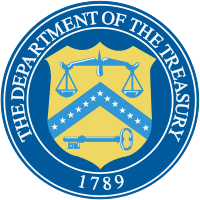 Seal of the Department | |
 Flag of the Secretary | |
| United States Department of the Treasury | |
| Style | Mr. Secretary |
| Member of | Cabinet National Security Council |
| Reports to | President of the United States |
| Seat | Washington, D.C. |
| Appointer | The President with Senate advice and consent |
| Term length | No fixed term |
| Constituting instrument | 31 U.S.C. § 301 |
| Formation | September 11, 1789 |
| First holder | Alexander Hamilton |
| Succession | Fifth[1] |
| Deputy | Deputy Secretary of the Treasury[2] |
| Salary | Executive Schedule, level I[3] |
| Website | www |
The secretary of the treasury, the secretary of state, the attorney general, and the secretary of defense are generally regarded as the four most important cabinet officials because of the size and importance of their respective departments.[5] The secretary of the treasury is a non-statutory member of the U.S. National Security Council and fifth in the United States presidential line of succession.
Powers and functions
The Secretary of the Treasury is the principal economic advisor to the President of the United States and plays a critical role in policy-making by bringing an economic and government financial policy perspective to issues facing the government. The Secretary is responsible for formulating and recommending domestic and international financial, economic, and tax policy, participating in the formulation of broad fiscal policies that have general significance for the economy, and managing the public debt. The Secretary oversees the activities of the Department in carrying out its major law enforcement responsibilities; in serving as the financial agent for the United States Government; and in manufacturing coins and currency. The Chief Financial Officer of the government, the Secretary serves as Chairman Pro Tempore of the President's Economic Policy Council, Chairman of the Boards and Managing Trustee of the Social Security and Medicare Trust Funds, and as U.S. Governor of the International Monetary Fund, the International Bank for Reconstruction and Development, the Inter-American Development Bank, the Asian Development Bank, and the European Bank for Reconstruction and Development.
— U.S. Department of the Treasury Web site[6]
The secretary along with the treasurer of the United States must sign Federal Reserve notes before they can become legal tender. The secretary also manages the United States Emergency Economic Stabilization fund.
Most of the department's law enforcement agencies such as the U.S. Customs Service, the Bureau of Alcohol, Tobacco, Firearms and Explosives (ATF), and the U.S. Secret Service were reassigned to other departments in 2003 in conjunction with the creation of the Department of Homeland Security.
The salary of the secretary of the treasury is $205,700 annually.
List of secretaries of the treasury
- Parties
No party (1) Federalist (4) Democratic-Republican (4) Democratic (29) Whig (5) Republican (34)
Status
| No. | Portrait | Name | State of Residence | Took Office | Left Office | President(s) | |
|---|---|---|---|---|---|---|---|
| 1 |  |
Alexander Hamilton | New York | September 11, 1789 | January 31, 1795 | George Washington | |
| 2 | 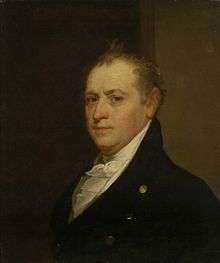 |
Oliver Wolcott, Jr. | Connecticut | February 3, 1795 | December 31, 1800 | ||
| John Adams | |||||||
| 3 |  |
Samuel Dexter | Massachusetts | January 1, 1801 | May 13, 1801 | ||
| Thomas Jefferson | |||||||
| 4 | Abraham Alfonse Albert Gallatin | Pennsylvania | May 14, 1801 | February 8, 1814 | |||
| James Madison | |||||||
| 5 |  |
George W. Campbell | Tennessee | February 9, 1814 | October 5, 1814 | ||
| 6 | 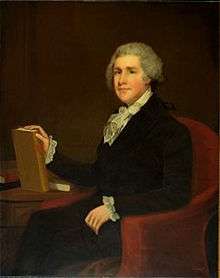 |
Alexander J. Dallas | Pennsylvania | October 6, 1814 | October 21, 1816 | ||
| – | 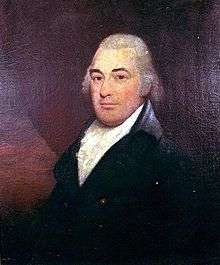 |
William Jones[1] Acting |
Pennsylvania | October 21, 1816 | October 22, 1816 | ||
| 7 |  |
William H. Crawford | Georgia | October 22, 1816 | March 6, 1825 | ||
| James Monroe | |||||||
| 8 | .jpg) |
Richard Rush | Pennsylvania | March 7, 1825 | March 5, 1829 | John Quincy Adams | |
| 9 |  |
Samuel D. Ingham | Pennsylvania | March 6, 1829 | June 20, 1831 | Andrew Jackson | |
| 10 | .jpg) |
Louis McLane | Delaware | August 8, 1831 | May 28, 1833 | ||
| 11 | 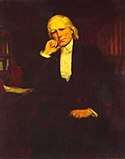 |
William J. Duane | Pennsylvania | May 29, 1833 | September 22, 1833 | ||
| 12 | 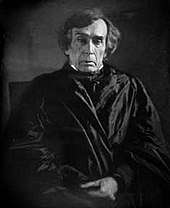 |
Roger B. Taney | Maryland | September 23, 1833 | June 25, 1834 | ||
| 13 |  |
Levi Woodbury | New Hampshire | July 1, 1834 | March 3, 1841 | ||
| Martin Van Buren | |||||||
| 14 |  |
Thomas Ewing | Ohio | March 4, 1841 | September 11, 1841 | William Henry Harrison | |
| John Tyler | |||||||
| 15 | 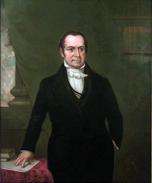 |
Walter Forward | Pennsylvania | September 13, 1841 | March 1, 1843 | ||
| 16 | 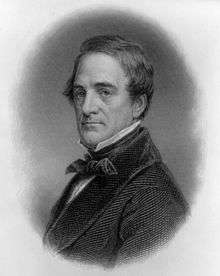 |
John C. Spencer | New York | March 8, 1843 | May 2, 1844 | ||
| 17 | 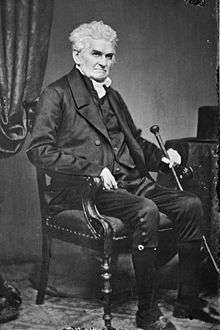 |
George M. Bibb | Kentucky | July 4, 1844 | March 7, 1845 | ||
| 18 | 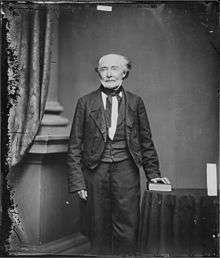 |
Robert J. Walker | Mississippi | March 8, 1845 | March 5, 1849 | James K. Polk | |
| 19 | 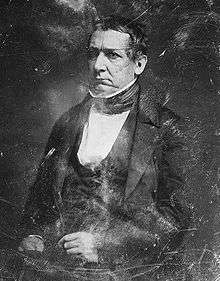 |
William M. Meredith | Pennsylvania | March 8, 1849 | July 22, 1850 | Zachary Taylor | |
| 20 | 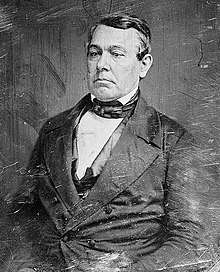 |
Thomas Corwin | Ohio | July 23, 1850 | March 6, 1853 | Millard Fillmore | |
| 21 | .jpg) |
James Guthrie | Kentucky | March 7, 1853 | March 6, 1857 | Franklin Pierce | |
| 22 | 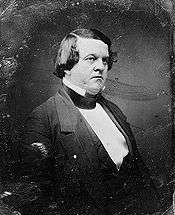 |
Howell Cobb | Georgia | March 7, 1857 | December 8, 1860 | James Buchanan | |
| 23 | 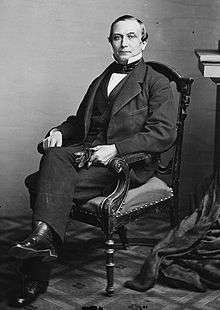 |
Philip Francis Thomas | Maryland | December 12, 1860 | January 14, 1861 | ||
| 24 | 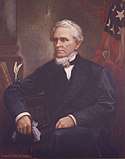 |
John Adams Dix | New York | January 15, 1861 | March 6, 1861 | ||
| 25 | .jpg) |
Salmon P. Chase | Ohio | March 7, 1861 | June 30, 1864 | Abraham Lincoln | |
| 26 | 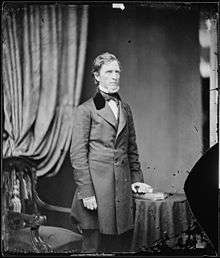 |
William P. Fessenden | Maine | July 5, 1864 | March 3, 1865 | ||
| 27 | 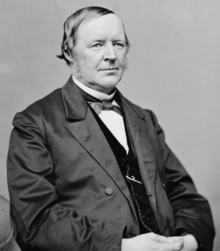 |
Hugh McCulloch | Indiana | March 9, 1865 | March 3, 1869 | ||
| Andrew Johnson | |||||||
| 28 | 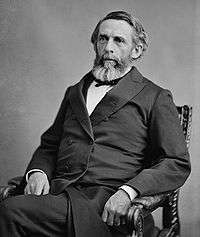 |
George S. Boutwell | Massachusetts | March 12, 1869 | March 16, 1873 | Ulysses S. Grant | |
| 29 |  |
William Adams Richardson | Massachusetts | March 17, 1873 | June 3, 1874 | ||
| 30 | 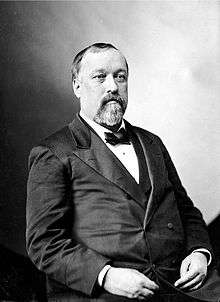 |
Benjamin Bristow | Kentucky | June 4, 1874 | June 20, 1876 | ||
| 31 | 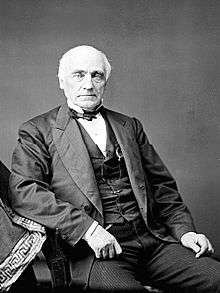 |
Lot M. Morrill | Maine | July 7, 1876 | March 9, 1877 | ||
| 32 | 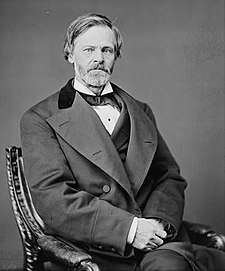 |
John Sherman | Ohio | March 10, 1877 | March 3, 1881 | Rutherford B. Hayes | |
| 33 |  |
William Windom | Minnesota | March 8, 1881 | November 13, 1881 | James A. Garfield | |
| Chester A. Arthur | |||||||
| 34 | 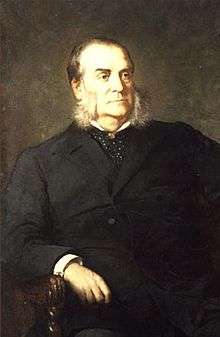 |
Charles J. Folger | New York | November 14, 1881 | September 4, 1884 | ||
| 35 |  |
Walter Q. Gresham | Indiana | September 5, 1884 | October 30, 1884 | ||
| 36 |  |
Hugh McCulloch | Indiana | October 31, 1884 | March 7, 1885 | ||
| 37 | .jpg) |
Daniel Manning | New York | March 8, 1885 | March 31, 1887 | Grover Cleveland | |
| 38 |  |
Charles S. Fairchild | New York | April 1, 1887 | March 6, 1889 | ||
| 39 |  |
William Windom | Minnesota | March 7, 1889 | January 29, 1891 | Benjamin Harrison | |
| 40 | 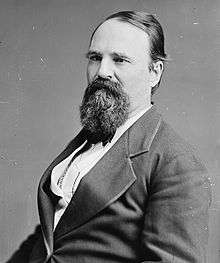 |
Charles Foster | Ohio | February 25, 1891 | March 6, 1893 | ||
| 41 | 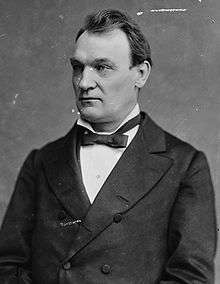 |
John G. Carlisle | Kentucky | March 7, 1893 | March 5, 1897 | Grover Cleveland | |
| 42 | 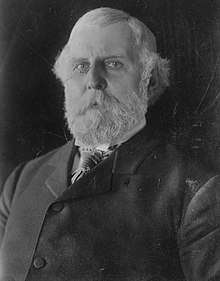 |
Lyman J. Gage | Illinois | March 6, 1897 | January 31, 1902 | William McKinley | |
| Theodore Roosevelt | |||||||
| 43 | 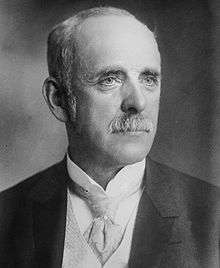 |
L. M. Shaw | Iowa | February 1, 1902 | March 3, 1907 | ||
| 44 | 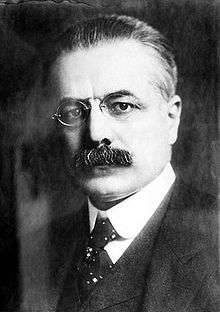 |
George B. Cortelyou | New York | March 4, 1907 | March 7, 1909 | ||
| 45 | 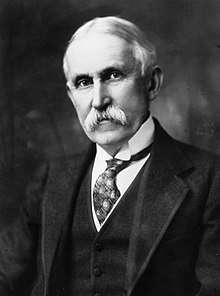 |
Franklin MacVeagh | Illinois | March 8, 1909 | March 5, 1913 | William Howard Taft | |
| 46 | 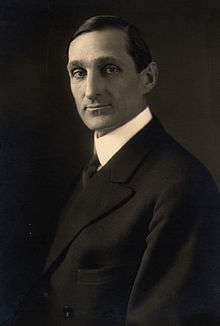 |
William G. McAdoo | New York | March 6, 1913 | December 15, 1918 | Woodrow Wilson | |
| 47 | 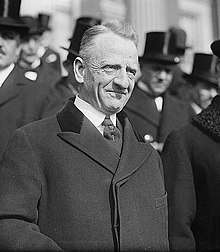 |
Carter Glass | Virginia | December 16, 1918 | February 1, 1920 | ||
| 48 | 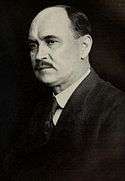 |
David F. Houston | Missouri | February 2, 1920 | March 3, 1921 | ||
| 49 |  |
Andrew W. Mellon | Pennsylvania | March 4, 1921 | February 12, 1932 | Warren G. Harding | |
| Calvin Coolidge | |||||||
| Herbert Hoover | |||||||
| 50 |  |
Ogden L. Mills | New York | February 13, 1932 | March 4, 1933 | ||
| 51 |  |
William H. Woodin | New York | March 5, 1933 | December 31, 1933 | Franklin D. Roosevelt | |
| 52 | 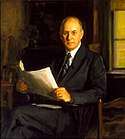 |
Henry Morgenthau, Jr. | New York | January 1, 1934 | July 22, 1945 | ||
| 53 | 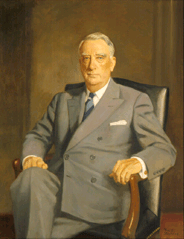 |
Fred M. Vinson | Kentucky | July 23, 1945 | June 23, 1946 | Harry S. Truman | |
| 54 | 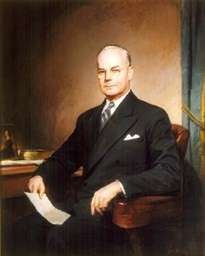 |
John Wesley Snyder | Missouri | June 25, 1946 | January 20, 1953 | ||
| 55 | 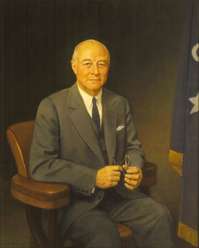 |
George M. Humphrey | Ohio | January 21, 1953 | July 29, 1957 | Dwight D. Eisenhower | |
| 56 | 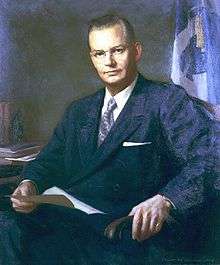 |
Robert B. Anderson | Connecticut | July 29, 1957 | January 20, 1961 | ||
| 57 | 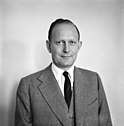 |
C. Douglas Dillon | New Jersey | January 21, 1961 | April 1, 1965 | John F. Kennedy | |
| Lyndon B. Johnson | |||||||
| 58 | 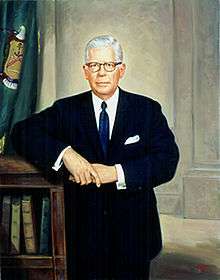 |
Henry H. Fowler | Virginia | April 1, 1965 | December 20, 1968 | ||
| 59 | 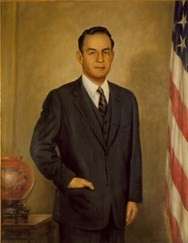 |
Joseph W. Barr | Indiana | December 21, 1968 | January 20, 1969 | ||
| 60 |  |
David M. Kennedy | Utah | January 22, 1969 | February 10, 1971 | Richard Nixon | |
| 61 | 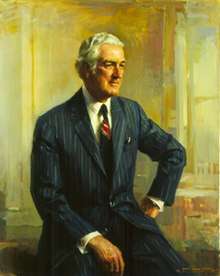 |
John Connally | Texas | February 11, 1971 | June 12, 1972 | ||
| 62 | 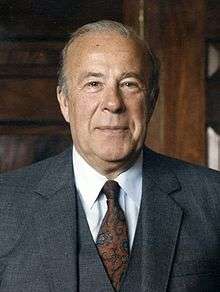 |
George P. Shultz | Illinois | June 12, 1972 | May 8, 1974 | ||
| 63 | 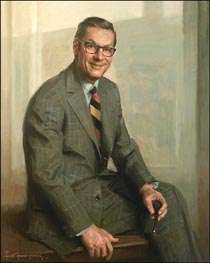 |
William E. Simon | New Jersey | May 8, 1974 | January 20, 1977 | ||
| Gerald Ford | |||||||
| 64 | 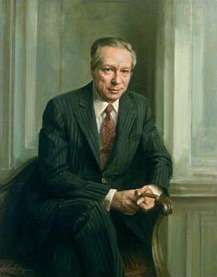 |
W. Michael Blumenthal | Michigan | January 23, 1977 | August 4, 1979 | Jimmy Carter | |
| 65 | 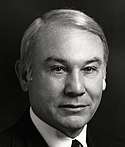 |
G. William Miller | Rhode Island | August 7, 1979 | January 20, 1981 | ||
| 66 |  |
Donald Regan | New Jersey | January 22, 1981 | February 1, 1985 | Ronald Reagan | |
| 67 | .jpg) |
James Baker | Texas | February 4, 1985 | August 17, 1988 | ||
| – | 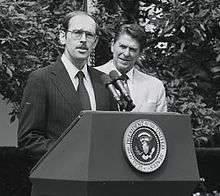 |
M. Peter McPherson[2] Acting |
Michigan | August 17, 1988 | September 15, 1988 | ||
| 68 | 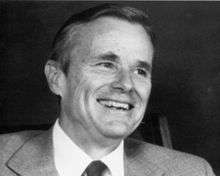 |
Nicholas F. Brady | New Jersey | September 15, 1988 | January 17, 1993 | ||
| George H. W. Bush | |||||||
| 69 | 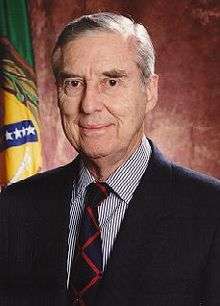 |
Lloyd Bentsen | Texas | January 20, 1993 | December 22, 1994 | Bill Clinton | |
| – | Frank N. Newman[3] Acting |
Massachusetts | December 22, 1994 | January 11, 1995 | |||
| 70 | 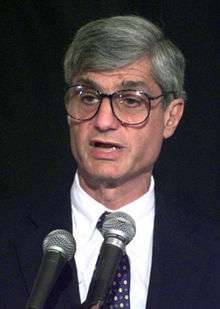 |
Robert Rubin | New York | January 11, 1995 | July 2, 1999 | ||
| 71 | 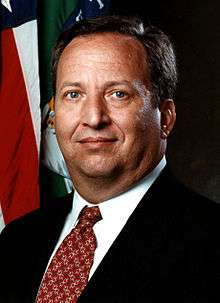 |
Lawrence Summers | Massachusetts | July 2, 1999 | January 20, 2001 | ||
| 72 | 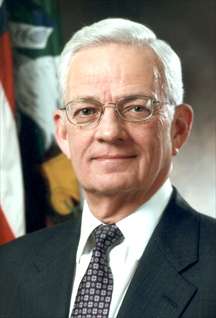 |
Paul H. O'Neill | Pennsylvania | January 20, 2001 | December 31, 2002 | George W. Bush | |
| – | 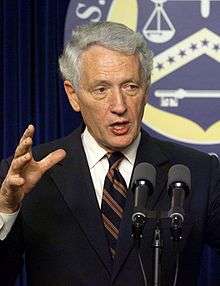 |
Kenneth W. Dam[4] Acting |
Illinois | December 31, 2002 | February 3, 2003 | ||
| 73 | 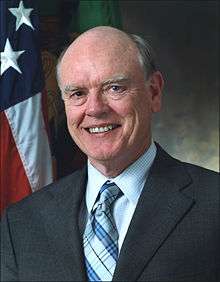 |
John W. Snow | Virginia | February 3, 2003 | June 30, 2006 | ||
| – |  |
Robert M. Kimmitt[5] Acting |
Virginia | June 30, 2006 | July 10, 2006 | ||
| 74 | 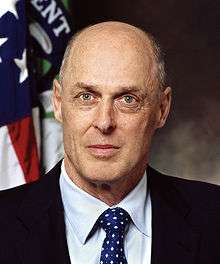 |
Henry Paulson | Illinois | July 10, 2006 | January 20, 2009 | ||
| – | 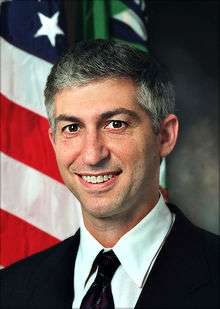 |
Stuart A. Levey[6] Acting |
Ohio | January 20, 2009 | January 26, 2009 | Barack Obama | |
| 75 |  |
Timothy Geithner | New York | January 26, 2009 | January 25, 2013 | ||
| – | 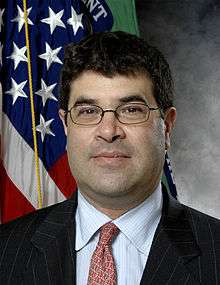 |
Neal S. Wolin[7] Acting |
Illinois | January 25, 2013 | February 28, 2013 | ||
| 76 | 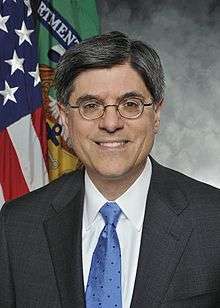 |
Jack Lew | New York | February 28, 2013 | January 20, 2017 | ||
| – |  |
Adam J. Szubin[8] Acting |
Washington, D.C. | January 20, 2017 | February 13, 2017 | Donald Trump | |
| 77 | .jpg) |
Steven Mnuchin | California | February 13, 2017 | Incumbent | ||
1 William Jones served as acting secretary between the resignation of Alexander J. Dallas and appointment of William H. Crawford.
2 Deputy Secretary of the Treasury M. Peter McPherson served as acting secretary of the treasury from August 17, 1988, to September 15, 1988.
3 Because of the resignation of Deputy Secretary of the Treasury Roger Altman in August 1994, Under Secretary of Treasury for Domestic Finance Frank N. Newman served from December 22, 1994, to January 11, 1995, as acting secretary of the treasury.
4 Deputy Secretary of the Treasury Kenneth W. Dam served as acting secretary of the treasury from December 31, 2002, to February 3, 2003.
5 Deputy Secretary of the Treasury Robert M. Kimmitt served as acting secretary of the treasury from June 30, 2006, to July 9, 2006.
6 Under Secretary for Terrorism and Financial Intelligence Stuart A. Levey served as acting secretary of the treasury from January 20, 2009, until the confirmation of Timothy Geithner, which occurred January 26, 2009.
7 Deputy Secretary of the Treasury Neal Wolin served as acting secretary of the treasury from January 25, 2013, until the confirmation of Jack Lew which occurred February 28, 2013.
8 Acting Under Secretary for Terrorism and Financial Intelligence Adam J. Szubin served as acting secretary of the treasury from January 20, 2017, until the confirmation of Steven Mnuchin which occurred February 13, 2017.
.png)
If both the secretary and the deputy secretary of the treasury are unable to carry out the duties of the office of secretary of the treasury, then whichever treasury official of under secretary rank sworn in earliest assumes the role of acting secretary. Positions listed on the Department of the Treasury website include the under secretary for domestic finance, the under secretary for international affairs, and the under secretary for terrorism and financial intelligence.
Living former secretaries of the treasury
As of August 2020, there are ten living former secretaries of the treasury (with all secretaries that have served since 2003 still living), the oldest being George P. Shultz (served 1972–1974, born 1920). The most recent secretary of the treasury to die, as well as the most recently serving secretary to die, was Paul H. O'Neill (served 2001–2002, born 1935), on April 18, 2020.
| Name | Term of office | Date of birth (and age) |
|---|---|---|
| George P. Shultz | 1972–1974 | December 13, 1920 |
| W. Michael Blumenthal | 1977–1979 | January 3, 1926 |
| James A. Baker | 1985–1988 | April 28, 1930 |
| Nicholas F. Brady | 1988–1993 | April 11, 1930 |
| Robert Rubin | 1995–1999 | August 29, 1938 |
| Lawrence H. Summers | 1999–2001 | November 30, 1954 |
| John W. Snow | 2003–2006 | August 2, 1939 |
| Henry Paulson | 2006–2009 | March 28, 1946 |
| Timothy F. Geithner | 2009–2013 | August 18, 1961 |
| Jack Lew | 2013–2017 | August 29, 1955 |
Notes
- https://www.law.cornell.edu/uscode/text/3/19
- 31 U.S.C. § 301
- 5 U.S.C. § 5312
- 31 U.S.C. § 301
- Cabinets and Counselors: The President and the Executive Branch (1997). Congressional Quarterly. p. 87.
- "Duties & Functions: Secretaries of the Treasury". United States Department of the Treasury. Archived from the original on November 19, 2010. Retrieved November 30, 2012.
References
- "Secretaries of the Treasury". History of the Treasury. United States Department of the Treasury. Retrieved April 9, 2006.
External links
| Wikimedia Commons has media related to United States Secretary of the Treasury. |
| U.S. order of precedence (ceremonial) | ||
|---|---|---|
| Preceded by David Souter as Senior Associate Justice |
Order of Precedence of the United States as Secretary of the Treasury |
Succeeded by Mark Esper as Secretary of Defense |
| U.S. presidential line of succession | ||
| Preceded by Secretary of State Mike Pompeo |
5th in line | Succeeded by Secretary of Defense Mark Esper |